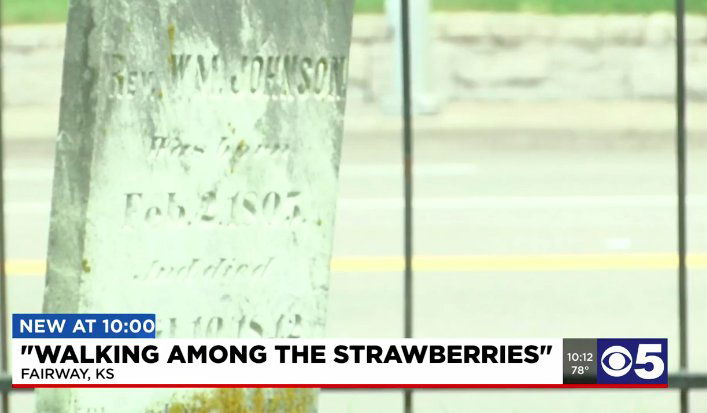Historians search for unmarked graves in cemetery

Click here for updates on this story
FAIRWAY, Kansas (KCTV) — Local historians and scientists are searching for unmarked graves in one of Johnson County’s most historically significant cemeteries.
The study is ongoing at the Shawnee Methodist Mission Cemetery, a Kansas State Historical site, located on Shawnee Mission Parkway and Canterbury Road.
The small plot of land is part of the Shawnee Indian Mission, which is now separated from the main grounds by the busy lanes and traffic and about a block of residential streets. When the Mission was functional in the 1800’s the site encompassed about 2,000 acres.
The cemetery is the final resting place for Reverend Thomas Johnson, a Methodist minister who moved to Kansas in the 1830’s to start a Methodist children’s school on Shawnee tribal land.
“Of course Thomas Johnson is the namesake of our county,” Shawnee Indian Mission volunteer librarian John Forbes said.
What started as a day school in Turner, Kansas, eventually became the Shawnee Indian Mission where the present day historical site sits in Fairway. It was a boarding school for Native American children of many tribes who were forcibly relocated to the Kansas City region.
“We had students here from 22 different tribes that I can document. One I can identify anecdotally. The majors ones would have Shawnee, the Delaware, Wyandot, Ottawa, Kanza and then smaller numbers of a large number of other tribes,” Forbes said.
The idea behind the mission was to provide the native children with transitional education to move from the life their grandparents lived, to the life the children would come to know in the American 1840s and 1850s.
“It was choice for their parents to send them here,” Forbes said. “The missionaries could not force any children to come, or put pressure. They could simply lay out the opportunities. But maybe the Chief could convince parents.”
The cemetery only has headstones for members of the Johnson family, who started the Mission and the church. But there’s a large section of the cemetery with no visible gravestones.
That’s why Forbes and other local historians decided to raise funds to do a study using ground penetrating radar and other technology to see what, if anything, lies under the grass.
“The idea that there might be native kids really touches my heart,” Kristen Zane said.
Zane is a member of the Wyandot Nation of Kansas. Also a retired engineer, she helped facilitate the study through a local company called Geo Technology.
“As a Wyandotte, we never say somebody has died,” Zane said. “We say they are walking among the strawberries. And we were doing the ground penetrating radar, I looked down and they were wild strawberries. I picked one up and I just cried.”
Forbes thinks it’s possible, but unlikely, that the study will result in finding unmarked graves of Native American students who attended the school.
“Those of the Shawnee, Delaware and Wyandot, if they had deaths in those tribes, they’re close enough that the families would have taken the bodies back their own cemeteries,” he said.
Forbes views of the origins of the Shawnee Indian Mission as history to be proud of. In his view, Thomas Johnson was a caring man dedicated to helping Native American children get the skills needed to thrive in the future.
“I say that carefully because some of that is my interpretation. I’m sure that if you went to Shawnee Oklahoma, and talked with the leadership there they would give you a slightly different perception. But that’s the way that I see it,” Forbes said.
You don’t have to go all the way to Oklahoma though to get a differing perception.
“One reason a lot of us do not know what our Native American heritage is, other than what has been made sure that we remember, are because our ancestor were afraid that their kids would be taken away from them,” Chief Judith Manthy of the Wyandot Nation of Kansas said.
Manthy believes every boarding school set up for Native American children by white settlers has a shameful history.
“They have sterilized Native American women. They have taken the kids away and put them in residential schools. And a lot of these parents never knew where their kids ended up. So Shawnee Mission is part of that,” Manthy said.
The Wyandot Nation of Kansas has fought to keep their own cemeteries from development. They see the project the Shawnee Methodist Cemetery as an opportunity to honor the natives who could have perished there, regardless if they’re Wyandot or not.
“Those poor kids. They didn’t have a choice. And that would never happen to any other group of people. It would never be stood for,” Second Chief Louisa Libby said.
The results of the study should be available in a few weeks time, offering the possibility of new information that could change the way we understand what happened on the Shawnee Indian Mission grounds more than 150 years ago, and what implications remain today.
“History is always an evolving story. It is not something that sits down and is a constant one point, this is it, this is everything. There are some constants. But an awful lot of history is the interpretation of the events of the past that make sense and are significant to the present,” Forbes said.
Please note: This content carries a strict local market embargo. If you share the same market as the contributor of this article, you may not use it on any platform.